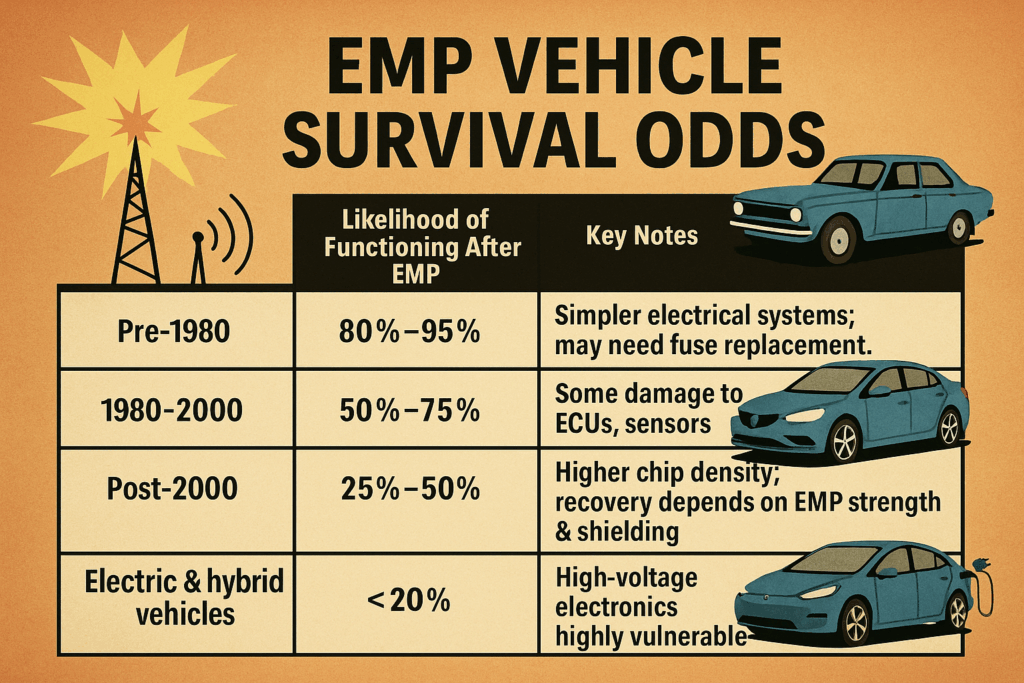If an electromagnetic pulse (EMP) ever hit the U.S.—whether from a high-altitude nuclear detonation or a massive solar storm—the survival of your vehicle would be a major concern. An EMP can instantly disable electronics, disrupt power grids, and bring modern transportation to a standstill. But will your car still run after an EMP? The answer depends on its age, design, and exposure level.
How an EMP Affects Vehicles
An EMP releases a burst of electromagnetic energy that can induce high voltages in electronic circuits. In vehicles, the main vulnerable components include:
- Electronic Control Modules (ECM/ECU)
- Ignition systems
- Fuel injection systems
- Sensors and relays
- Onboard entertainment/navigation systems
Older cars with minimal or no electronics are generally less susceptible, while newer vehicles rely heavily on sensitive microchips.
Probability by Vehicle Age
Research by the EMP Commission and various independent studies gives us some insight:
| Vehicle Type | Likelihood of Functioning After EMP | Key Notes |
|---|---|---|
| Pre-1980 vehicles (mostly carbureted, minimal electronics) | 80%–95% likely to survive | Simpler electrical systems; may need fuse replacement. |
| 1980–2000 vehicles (early electronic fuel injection) | 50%–75% likely to survive | Some damage possible to ECUs, sensors. |
| Post-2000 vehicles (computer-controlled everything) | 25%–50% likely to survive | Higher chip density; recovery depends on EMP strength & shielding. |
| Electric & hybrid vehicles | <20% likely to survive | High-voltage electronics highly vulnerable; battery management systems at risk. |

Factors That Influence Your Odds
- EMP Intensity & Distance from Burst
- The closer you are to the epicenter, the greater the pulse strength.
- Vehicle Location
- Underground garages, metal barns, or shipping containers can act as Faraday cages.
- Design & Electronics Load
- More electronics = more vulnerability.
- Aftermarket Modifications
- Added electronics (LED light bars, upgraded stereos) can increase risk.
Real-World Testing
The U.S. EMP Commission tested 37 vehicles ranging from 1986 to 2002. Results showed most cars still ran after exposure to lower-level simulated EMP, though some stalled and had to be restarted. At higher simulated strengths, more failures occurred, primarily in newer models.
Protecting Your Vehicle
If EMP preparedness is important to you, consider these measures:
- Own a pre-1980 backup vehicle with no solid-state electronics.
- Store spare ECUs and critical components in a Faraday cage.
- Park in shielded storage like a metal outbuilding or EMP-rated garage.
- Keep essential spares (alternator, ignition coil, sensors) in EMP protection bags.
Bottom Line
The probability that your car will function after an EMP isn’t a simple yes-or-no answer.
- Older vehicles: very high survival rates.
- Newer vehicles: mixed results, but not an automatic death sentence.
- Hybrids/electrics: least likely to recover without major repairs.
In short: if an EMP hits, you’ll wish you had a low-tech backup ride, some spare parts, and a little shielding between your vehicle and the sky.


